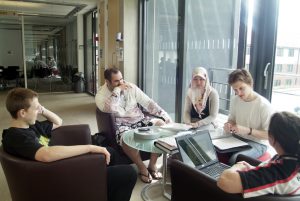As part of the online learners’ study I was asked to write a short review of what the previous studies have taught us. Of course there is no substitute for engaging with that work, especially as each team took a different focus. The original HE study considered learners’ transactional and transformational engagements with technology, and how their expectations about learning with technology were set by their lecturers and the demands of their course. The FE study looked more closely at how learners differ among themselves, whether they are ‘mainstream pragmatists’, digital pioneers, or have various kinds of digital disadvantage. The Skills study looked particularly at the interface between learning and work.
Here are some of the lessons I think we’ve learned across all three studies, with thanks to Ellen Lessner, Dave White, Nick Jeans and Rhona Sharpe – members of the original study teams – for their comments.
1. Learners expect digital technologies to facilitate their transactions with service providers, including learning providers. For example, they they want support for bringing and using their own devices on campus.
2. Learners still want fixed computing facilities to allow them to access learning content, specialist software and institutional systems, and to print. This is true even in settings where most have access to their own networked laptop, tablet or other device.
3. Learners want their course of study to include digital practices and technologies that will equip them for work. Use of workplace technologies, including up-to-date specialist software and systems, is important to most learners.
4. Learners are divided on whether their post-compulsory learning should include basic ICT skills or issues of e-safety and ethical/responsible behaviour. Some feel that these should already have been covered, for example in school. Generally, though, they believe that digitally disadvantaged learners should be supported to reach the required standard rather than missing out on opportunities.
5. Pedagogical uses of digital technology that have been positive and even transformational for learners include:
- using personal technologies to develop independent study habits e.g. note-taking, file management
- practicing subject-specialist applications such as data analysis, design, project management, use of specialist digital tools;
- discussion, sharing of ideas and collaboration with others;
- collation, curation and showcasing of their achievements e.g. in blogs, online CVs, professional sharing platforms and eportfolios.
6. However, incoming learners have very little idea about how digital technologies might be used pedagogically, other than in ways that replicate their previous experiences e.g. in school.
7. The reviewed literature and our consultation exercises indicate that learners want the use of digital technology in their learning to:
- respect their individual differences, preferences and access needs;
- support their own use of their own devices and services;
- give them a sense of belonging to the institution and a cohort;
- allow them to express their digital identity e.g. through the use of profiles, personalised interfaces, social networking features;
- be consistent in terms of access and quality of experience (not necessarily the same technologies used on all courses);
- have an educational rationale, rather than e.g. an economic rationale (saving money, dealing with higher numbers);
- reflect the quality and production values of the digital content they access for personal use;
- be mediated by teachers who are digitally confident and proficient;
- keep them safe from negative online behaviours;
- provide bounded spaces for the rehearsal of emergent identities;
- support the central place of the learning/teaching relationship.
8. Within the same cohort, learners have different experiences of the digital technologies and online spaces offered, and come to learning with different levels of confidence and digital capital.
- The majority of learners – the ‘mainstream pragmatists’* – accept the digital infrastructure and technologies they are offered. They look to teaching staff and course requirements to guide their online activities, and need clarity about expectations and norms.
- Learners who are highly proficient and confident with digital technologies are likely to use a mix of personal and provider technologies. Their know-how can be a resource for others, if they are allowed to express it. A flexible and innovative digital environment supports them best.
- Learners who are digitally disadvantaged – for whatever reason – are focused on access and functional skills. These learners are likely to need support to acquire new skills and to participate fully. A secure and highly structured digital environment supports them best.
- There are also significant cultural differences in how learners engage in online spaces.
10. Learners with disabilities and access needs have particular requirements. Digital provision can support these learners well, because it allows for them to participate via their own prefered devices and via interfaces which are adapted to their needs. However, digital systems and digital content must be designed to be accessible to all.
11. In addition to these perceived and experienced differences, there continue to be very real differences between courses and course providers in terms of the digital technologies available, the support given to learners’ developing digital practices, and the confidence of practitioners.
12. Learners want to be consulted about their experiences with technology in the learning environment. Many have valuable ideas and skills to offer.
Many of these issues are summarised in the Jisc/NUS benchmarking tool: Enhancing the Student Digital Experience. This is being rolled out for use by NUS change agents and other student representatives, so may be coming to your institutions soon. You can also follow the development of the Digital Student/Learner Experience Tracker tool, which captures a snapshot of what current learners think.




